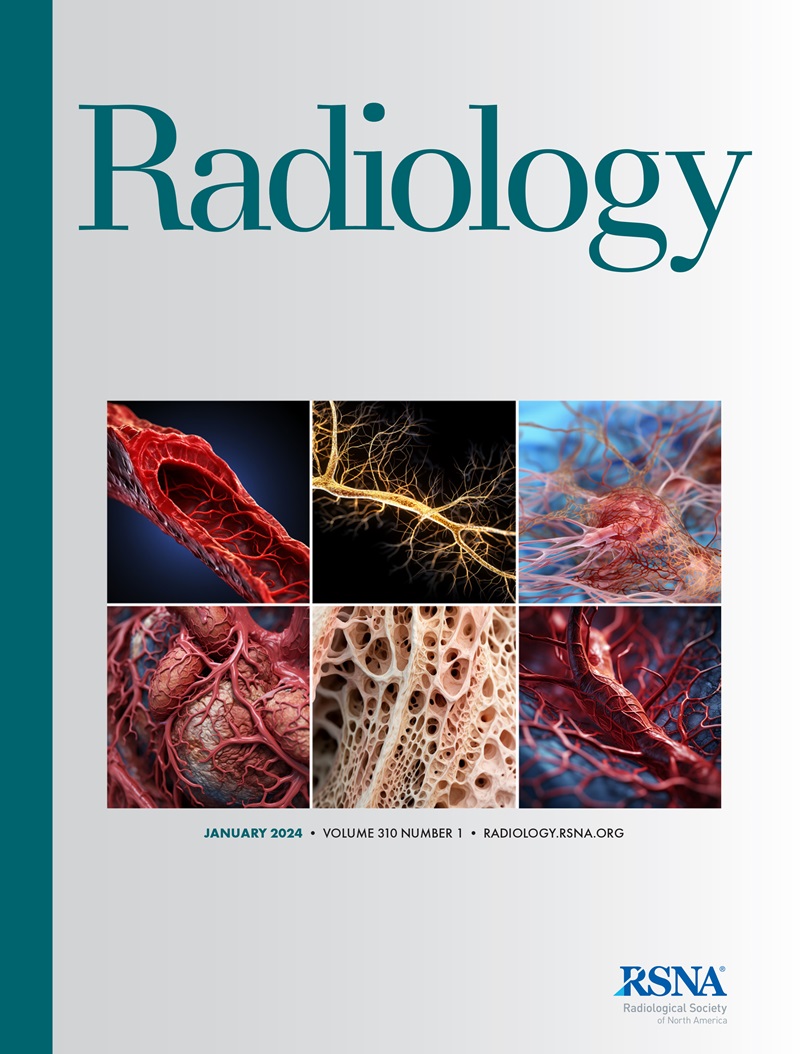Microbubble-based Radiosensitization of Hepatocellular Carcinoma: Evaluation of Safety and Efficacy in a Phase II Randomized Trial.
IF 15.2
1区 医学
Q1 RADIOLOGY, NUCLEAR MEDICINE & MEDICAL IMAGING
Corinne E Wessner, Flemming Forsberg, Andrej Lyshchik, Patrick O'Kane, Kristen Bradigan, Ji-Bin Liu, Lauren J Delaney, Kevin Anton, Stephen R Topper, Jesse Civan, Warren Maley, Scott W Keith, Colette M Shaw, John R Eisenbrey
下载PDF
{"title":"Microbubble-based Radiosensitization of Hepatocellular Carcinoma: Evaluation of Safety and Efficacy in a Phase II Randomized Trial.","authors":"Corinne E Wessner, Flemming Forsberg, Andrej Lyshchik, Patrick O'Kane, Kristen Bradigan, Ji-Bin Liu, Lauren J Delaney, Kevin Anton, Stephen R Topper, Jesse Civan, Warren Maley, Scott W Keith, Colette M Shaw, John R Eisenbrey","doi":"10.1148/radiol.250083","DOIUrl":null,"url":null,"abstract":"<p><p>Background US contrast agents are gas-filled microbubbles that can be disrupted locally, such as via ultrasound-triggered microbubble destruction (UTMD), which can cause bioeffects that sensitize tumors to radiation. However, the efficacy and safety of UTMD combined with radiation therapy in participants with hepatocellular carcinoma (HCC) are unknown. Purpose To determine the treatment efficacy and safety of UTMD in participants with HCC receiving yttrium 90 (<sup>90</sup>Y) transarterial radioembolization (TARE). Materials and Methods In this prospective phase II clinical trial conducted from July 2017 to February 2024, participants with HCC scheduled for <sup>90</sup>Y-TARE were randomly assigned to undergo <sup>90</sup>Y-TARE with three UTMD sessions (treatment group) or <sup>90</sup>Y-TARE alone (control group). The primary end point was treatment response evaluated at MRI or CT using modified Response Evaluation Criteria in Solid Tumors. Secondary end points included safety, overall survival, time to next treatment, rate of liver transplantation, and pathologic response in the event of transplantation. Changes in general laboratory values and vital signs were compared using unpaired and paired <i>t</i> tests, survival and time to next treatment between groups were compared between groups using log-rank tests, and treatment response distribution was compared between groups using the Mann-Whitney <i>U</i> test. Results The study sample consisted of 98 participants (mean age, 69 years ± 8.4 [SD]; 71 men). The safety analysis showed no evidence of a difference in vital signs before versus after the initial UTMD session in the treatment group (all <i>P</i> ≥ .07). There was also no evidence of a difference in changes in general laboratory values from before to after treatment between the treatment and control groups (all <i>P</i> ≥ .08). In the control group, 34% (17 of 50) of participants had stable disease, 22% (11 of 50) had partial response, and 44% (22 of 50) had complete response; in the treatment group, 4% (two of 48) had stable disease, 35% (17 of 48) had partial response, and 60% (29 of 48) had complete response. Thus, UTMD increased the proportion of participants who experienced complete or partial response by 30 percentage points (96% [46 of 48] vs 66% [33 of 50]; <i>P</i> = .01). Overall survival was higher in the treatment group than in the control group (mortality hazard ratio, 0.51 [95% CI: 0.28, 0.95]; <i>P</i> = .03). Conclusion Compared with only <sup>90</sup>Y-TARE, adding microbubble-based radiosensitization via UTMD to <sup>90</sup>Y-TARE in the treatment of HCC had similar safety, provided improved treatment response, and prolonged survival. ClinicalTrials.gov Identifier: NCT03199274 © RSNA, 2025 <i>Supplemental material is available for this article.</i></p>","PeriodicalId":20896,"journal":{"name":"Radiology","volume":"316 3","pages":"e250083"},"PeriodicalIF":15.2000,"publicationDate":"2025-09-01","publicationTypes":"Journal Article","fieldsOfStudy":null,"isOpenAccess":false,"openAccessPdf":"https://www.ncbi.nlm.nih.gov/pmc/articles/PMC12501628/pdf/","citationCount":"0","resultStr":null,"platform":"Semanticscholar","paperid":null,"PeriodicalName":"Radiology","FirstCategoryId":"3","ListUrlMain":"https://doi.org/10.1148/radiol.250083","RegionNum":1,"RegionCategory":"医学","ArticlePicture":[],"TitleCN":null,"AbstractTextCN":null,"PMCID":null,"EPubDate":"","PubModel":"","JCR":"Q1","JCRName":"RADIOLOGY, NUCLEAR MEDICINE & MEDICAL IMAGING","Score":null,"Total":0}
引用次数: 0
引用
批量引用
Abstract
Background US contrast agents are gas-filled microbubbles that can be disrupted locally, such as via ultrasound-triggered microbubble destruction (UTMD), which can cause bioeffects that sensitize tumors to radiation. However, the efficacy and safety of UTMD combined with radiation therapy in participants with hepatocellular carcinoma (HCC) are unknown. Purpose To determine the treatment efficacy and safety of UTMD in participants with HCC receiving yttrium 90 (90 Y) transarterial radioembolization (TARE). Materials and Methods In this prospective phase II clinical trial conducted from July 2017 to February 2024, participants with HCC scheduled for 90 Y-TARE were randomly assigned to undergo 90 Y-TARE with three UTMD sessions (treatment group) or 90 Y-TARE alone (control group). The primary end point was treatment response evaluated at MRI or CT using modified Response Evaluation Criteria in Solid Tumors. Secondary end points included safety, overall survival, time to next treatment, rate of liver transplantation, and pathologic response in the event of transplantation. Changes in general laboratory values and vital signs were compared using unpaired and paired t tests, survival and time to next treatment between groups were compared between groups using log-rank tests, and treatment response distribution was compared between groups using the Mann-Whitney U test. Results The study sample consisted of 98 participants (mean age, 69 years ± 8.4 [SD]; 71 men). The safety analysis showed no evidence of a difference in vital signs before versus after the initial UTMD session in the treatment group (all P ≥ .07). There was also no evidence of a difference in changes in general laboratory values from before to after treatment between the treatment and control groups (all P ≥ .08). In the control group, 34% (17 of 50) of participants had stable disease, 22% (11 of 50) had partial response, and 44% (22 of 50) had complete response; in the treatment group, 4% (two of 48) had stable disease, 35% (17 of 48) had partial response, and 60% (29 of 48) had complete response. Thus, UTMD increased the proportion of participants who experienced complete or partial response by 30 percentage points (96% [46 of 48] vs 66% [33 of 50]; P = .01). Overall survival was higher in the treatment group than in the control group (mortality hazard ratio, 0.51 [95% CI: 0.28, 0.95]; P = .03). Conclusion Compared with only 90 Y-TARE, adding microbubble-based radiosensitization via UTMD to 90 Y-TARE in the treatment of HCC had similar safety, provided improved treatment response, and prolonged survival. ClinicalTrials.gov Identifier: NCT03199274 © RSNA, 2025 Supplemental material is available for this article.
基于微泡的肝细胞癌放射增敏:II期随机试验的安全性和有效性评估。
美国造影剂是充满气体的微泡,可以局部破坏,如通过超声触发的微泡破坏(UTMD),这可以引起生物效应,使肿瘤对辐射敏感。然而,UTMD联合放疗对肝细胞癌(HCC)患者的疗效和安全性尚不清楚。目的探讨UTMD对接受90钇(90Y)经动脉放射栓塞(TARE)治疗的HCC患者的治疗效果和安全性。在2017年7月至2024年2月进行的这项前瞻性II期临床试验中,计划接受90Y-TARE治疗的HCC患者被随机分配到90Y-TARE联合3次UTMD治疗组(治疗组)或单独接受90Y-TARE治疗组(对照组)。主要终点是在MRI或CT上使用改进的实体瘤反应评价标准评估治疗反应。次要终点包括安全性、总生存期、到下一次治疗的时间、肝移植率和移植后的病理反应。使用非配对和配对t检验比较一般实验室值和生命体征的变化,使用log-rank检验比较组间生存和到下一次治疗的时间,使用Mann-Whitney U检验比较组间治疗反应分布。结果研究样本包括98名参与者(平均年龄69岁±8.4 [SD]; 71名男性)。安全性分析显示,治疗组首次UTMD治疗前后的生命体征无差异(P均≥0.07)。治疗组和对照组治疗前后一般实验室值的变化也无差异(P均≥0.08)。在对照组中,34%(17 / 50)的参与者病情稳定,22%(11 / 50)部分缓解,44%(22 / 50)完全缓解;在治疗组中,4%(48人中2人)病情稳定,35%(48人中17人)部分缓解,60%(48人中29人)完全缓解。因此,UTMD将经历完全或部分缓解的参与者比例提高了30个百分点(96% [46 / 48]vs 66% [33 / 50]; P = 0.01)。治疗组总生存率高于对照组(死亡率风险比为0.51 [95% CI: 0.28, 0.95]; P = 0.03)。结论与仅90Y-TARE相比,在90Y-TARE基础上加入UTMD微泡放射增敏治疗HCC具有相似的安全性,改善了治疗反应,延长了生存期。ClinicalTrials.gov标识符:NCT03199274©RSNA, 2025本文提供补充材料。
本文章由计算机程序翻译,如有差异,请以英文原文为准。

 求助内容:
求助内容: 应助结果提醒方式:
应助结果提醒方式:


